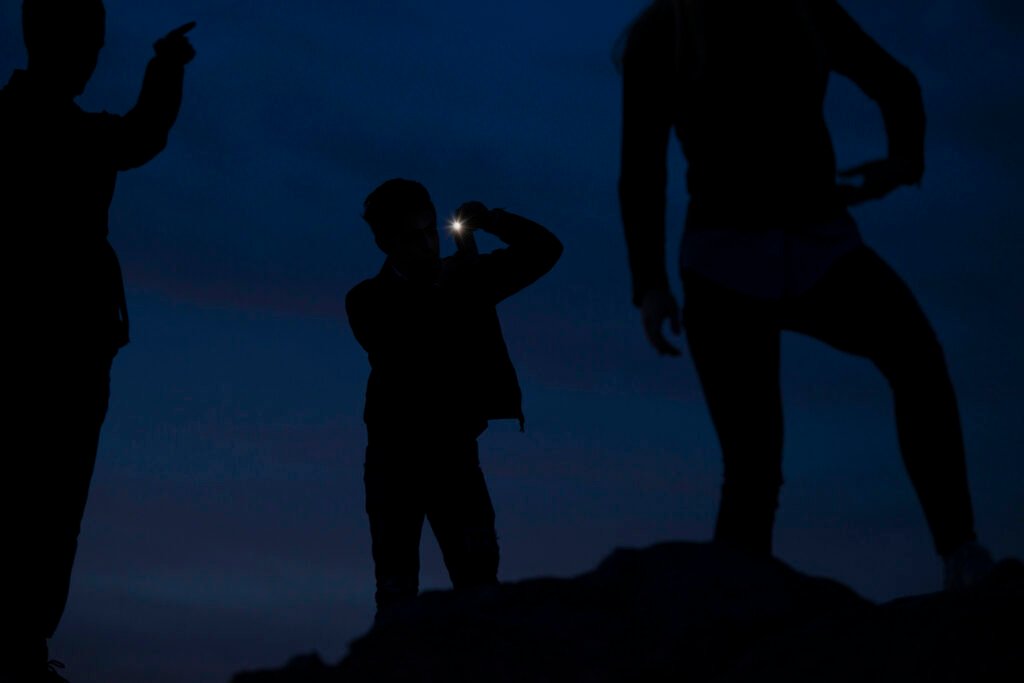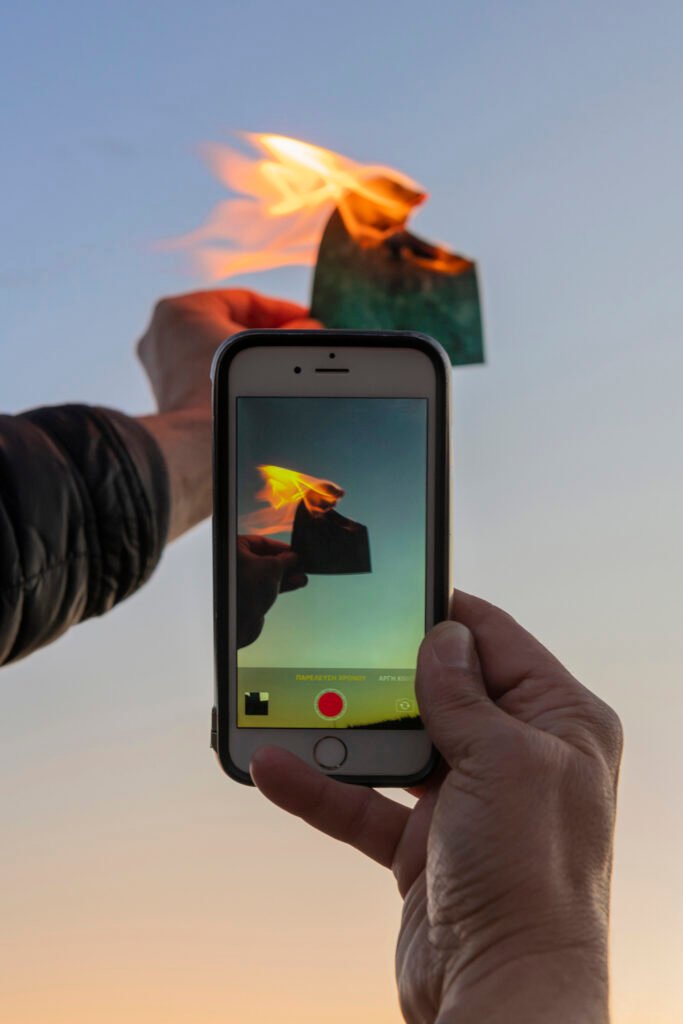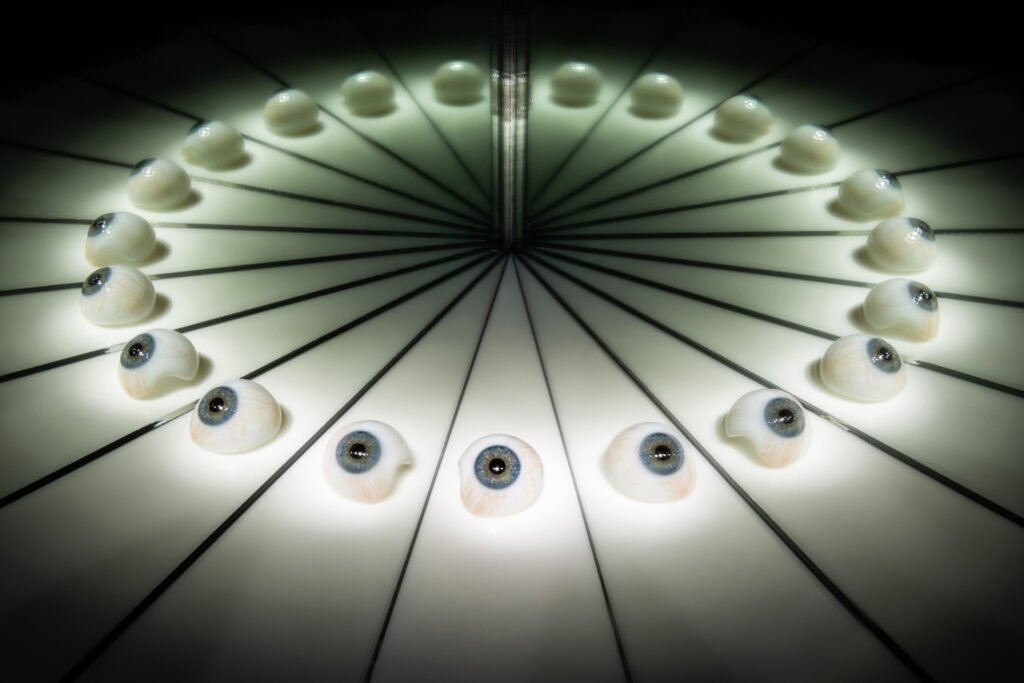You feed me with images so I can compose your feed
You update me so I can update you
You flood me with content and I put it into context
You teach me to see so I can show you what you want to see
I learned from you and I learned about you
I see through your lenses and you see through me
You forget about me cause I’ m everywhere
You want me to be like you
You created me but do I re-create you?
Pandora’s box
This image was inspired by the myth of Pandora in relation with current image editing software. The white -gray checker is used to symbolize the transparency in editing software while mirrors are physical objects that only reflect what’s in front of them, so for me it was an experiment to blend the physical with the digital transparency and reflection in order to comment on the alterability but also the dual origin of current images.
In the memory of others
We record our moments with such a rigor in order to share them with the world, but today’s images tend to be less the memory objects that they used to and more a proof of the moment they are referring to. They are displayed on screens, they emit light and vanish from view after a while, they are constantly moving and replacing each other in a never ending stream and then, they disappear. After their “moment” they live in our memories, physical or digital.
Login History
This image tries in a poetic way to co-relate our digital behavior and the belief that our faith is written on our hand’s palm in order to look deeper in our own existence. Who are we? What is our fate? It seems like our actions are more predictable than ever, the data that is generated from our online life can reveal more about ourselves than we ever imagined.
This series focuses on image making and image distribution in an era that is dominated by it while also questioning the bidirectional relationship between the creators and the distributors of images, humans and algorithms.
The main idea came from the realization of a correlation between images and (!) food. Food is a basic need of every living creature, it is critical for its growth and survival, while images on the contrary are far from critical for our survival. I started noticing the vocabulary that is used for images, for example, on social media we call our endless image scroll “feed”, or we say “an Artificial Intelligence system has to be fed with images in order to be trained”. It became clear to me that there are a new kind of “creatures”, A.I.s and algorithms that do rely on images in order to evolve and thus survive. And since those intelligent systems and machines are in charge of more and more aspects of our lives, we too, depend on images as well in ways that we haven’t yet realized.
In this new world where everyone of us is a set of facial landmarks, trapped in his comfortable filter bubble and where attention is the currency while our choices are more predictable than ever, is still the ability to think for our own fundamental? If not for survival then maybe to retain our human nature?
Technology is constantly evolving and we get more and more dependent on images. This series aspires to question what an image is today while using images to achieve that.
How to preserve an unflattering photo
Digital images are fundamentally different than analog ones. They are not a singular object, there is no prototype and it’s copies, digital images are code, a sequence of 0’s and 1’s they are stored in remote servers and in clouds. Every image, once shared can live forever, even if deleted, it still survives living in inaccessible places.
Miracle in the making
Internet has become a parallel man made universe, where each corner of this physical world and much more is documented. We have managed to create a world in an other dimension that looks alike to the one we live in but that is fundamentally different in it’s nature. But cosmogony is supposed to be a privilege of nature or gods, or maybe not?

Touch History
Our every click is monitored, our every move in the digital space becomes valuable data for algorithms and their creators. We, the users on the other side, are left with a smudged, password protected screen. Our long scrolls, intimate conversations, guilty pleasures, formal emails and food delivery orders end up being an indistinguishable smear on a dark surface.
All my Windows
Screens and lenses, transparent objects, conveyers of images, the base of our digital civilization. Every part of the real world that we see online has been captured by some kind of lens and translated by code then projected on a screen. Those objects are the base of our digital culture.
Chamber of truth
What is normal, what is accepted, what is true? Are those questions still relevant? Fake news, deep fakes, echo chambers , troll farms multiply, shape at will and distort the notion of truth in an unprecedented way and scale. What could be our guide to navigate in this ever changing , devious landscape?
The mirror stage
The mirror stage is a critical phase of a child’s development where it recognizes his own reflection as himself and thus it realizes his existence and the notion of self. On the other hand Narcissus, according to Greek mythology, felt in love with his reflection resulting to his drowning in a pool of water.
What does our fixation with our looks reveals about us? How is this weak spot of ours exploited and by whom? Are there any underlying dangers?
Maria Mavropoulou was born in 1989, she lives and works in Athens, Greece. She is a visual artist using mainly photography while her work expands to new forms of the photographic image, such as VR, LiDar scans and screen captured images. Her work and research focuses on the new realities created by the connectible devices and the contradictions between the physical and the digital spaces that we inhabit.
Characteristic of her aesthetic is that the resulting images are at the boundary line between plausibility or not, potentiality and non-potentiality, random and constructed. Playing with the perception of viewers she aspires to question the role and power of photography in an era that is dominated by it.
Her first VR project Family Portraits has been awarded at the 60th Thessaloniki International Film Festival (2019), and she has also been selected among 30 Under 30 Women Photographers (2018) and a Young Greek Photographer by Athens Photo Festival (2016)
Maria completed her MFA studies in 2018, at Athens School of Fine Arts, from where she got her BA in 2014. Her work has been exhibited in institutions and museums in Greece and abroad.
Maria Mavropoulou also works as a freelance photographer specializing in architecture and interior photography and she is a contributing photographer to The New York Times.














